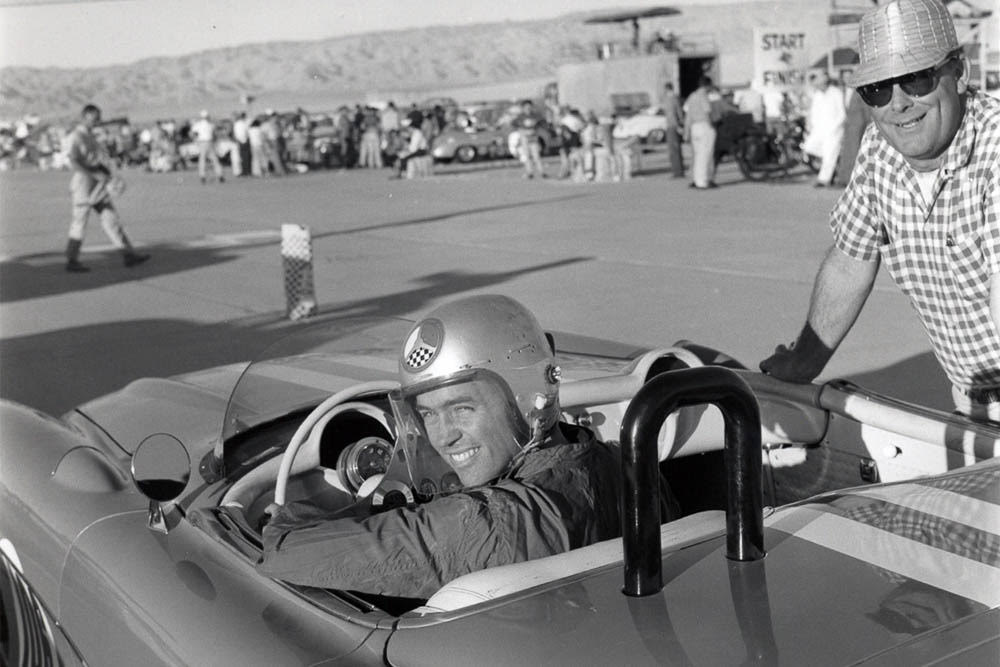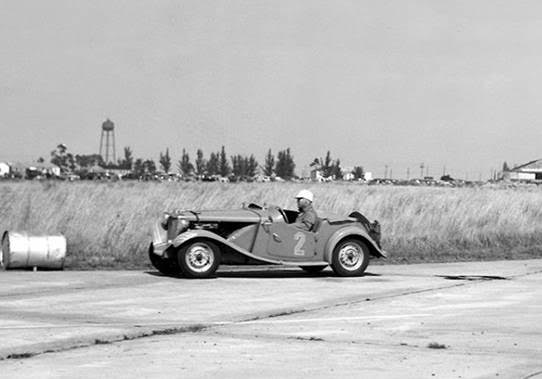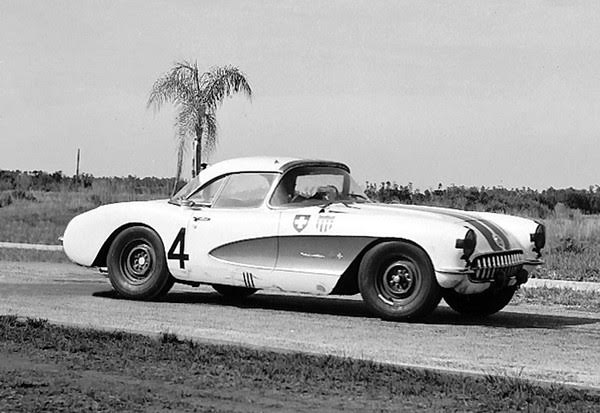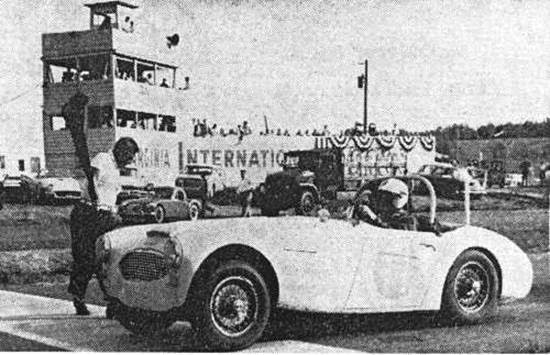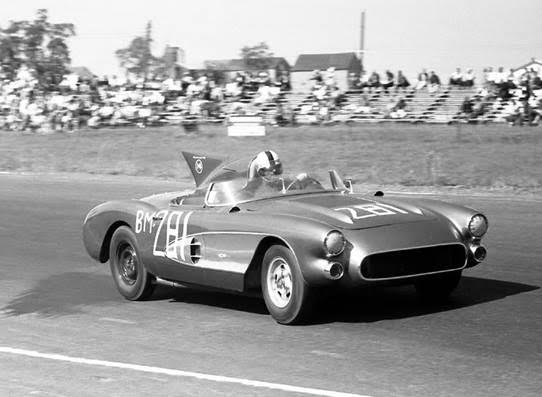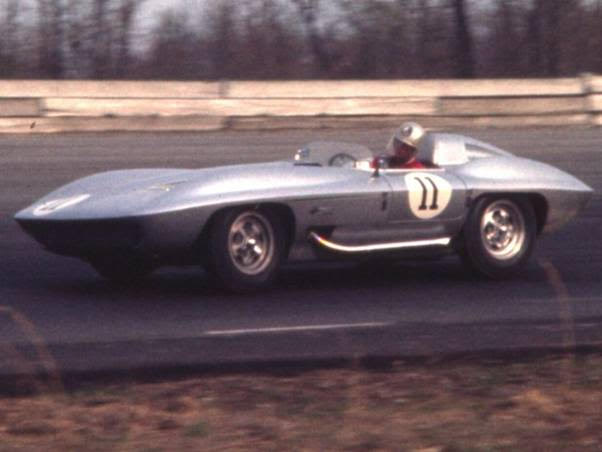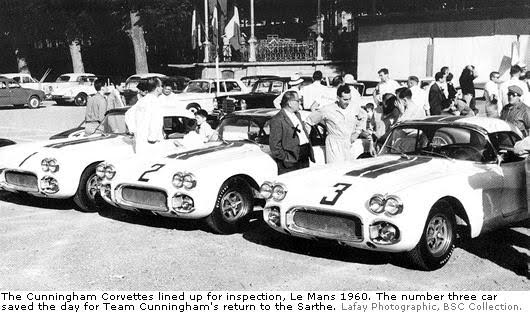Dr. Richard K. Thompson, Jr.
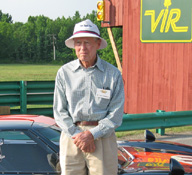
“The original “Flying Dentist”, Dick won numerous Sports Car Club of America championships and was inducted in the Corvette Hall of Fame. In the 1970s, he raced for the factory Corvette team of Briggs Cunningham. He began racing in 1952 in one of the first 12 hour races at Sebring International Raceway driving to the track in his MG TD. He caught Corvette engineer Zora Arkus-Duntov’s eye in 1956 when he was the only driver to compete in a production Corvette… won the SCCA championship in his Corvette in 1956, 1957, 1960, 1961 and 1962 in Classes A, B and C. His title in 1962 was his 7th – the most SCCA national championships of any driver to that point. He was selected to test drive a new Corvette Grand Sport at Sebring in December 1962. In 1963, he drove a Corvette Grand Sport to victory at Watkins Glen International. He took third place that year at Daytona International Speedway and won the GT class in 1970. Below is an article from Fast Chevys:
Dr. Dick Thompson Remembers
IFrom FAST CHEVYs by Alex & Mary Gabbard
August 27, 2017
I got started toward racing when I bought a Renault 4CV in 1948 or 1949. That got me into foreign cars. After that, I bought a Morris Minor from a local dealer. A friend of mine told me about a local rally where they raced such cars, & while there, I saw an MG-TD. The Morris dealer also handled MG, so I bought one. Another friend, Bill Kinchloe, told me about races w/MGs at Watkins Glen (NY), so we went. Someone told us about a race in Florida at Sebring in March, & Bill & I decided to go.
It was an AAA race & all you had to do to get a license was sign in. We signed up & we were in the race. We raced my MG-TD. Someone had told us that you couldn’t race the whole thing on one set of tires & wheels so we took along a spare set from Bill’s MG. This was 1952.
We won a trophy! We finished 8th OA (#2 above), 6th on handicap & 3rd in the 1500cc class. (This was the 1st Sebring 12-Hour. Completed 129 laps, 670.8 miles. Averaged 55.9 mph). I had only seen one race before & here we won the J.S. Inskip trophy for outstanding MG performance. Inskip was the MG importer in my area & awarded the trophy for the highest finishing stock MG.
It was the very 1st race for both of us. We only had one helmet. In practice, both of us were in the car where we critiqued each other’s driving. I was a practicing dentist at the age of 32 & just a “weekend warrior” racer.
After Sebring, we towed the tired MG back to Washington, D.C. where we rebuilt it. I started going to local races, mostly in Pennsylvania — the Reading Hill Climb (PA), Giant’s Despair, Watkins Glen (NY) & others. At Watkins Glen, Bill Spear was in an OSCA. Bob Fergus w/his MG-TC & I had a great race. Both of us finished. Bob won & rec’d a trophy for the 1st place MG.
The course went thru town & out around the countryside. Coming back into town, the course went downhill w/a sharp left, then a hard right onto main street. Downhill, the car was turning 6500 rpm, much more than it was really capable of, but it held together. There were two (2) OSCAs in the 1500cc class, but I finished 3rd or 4th in class w/them.
In 1953 I bought one of the 1500cc Porsches. In those days, they were mostly VWs. By then, the MG wasn’t very competitive & could only run for special trophies. Later, the Porsches became so popular that many of the events became virtually Porsche races.
That year, I was recalled into the Marines because of the Korean War. I had been in the Marines after graduating in 1944 & had been in the 2nd World War. I was sent to Paris Island (SC) as a dentist I arranged w/the Marines to be let off for racing, which they thought was a good idea for exposure. They let me race at Bridgehampton (NY) where I won the 1500cc class in the Porsche. What made that win so interesting was that I drove up, won the race against a special Glockler Porsche** & drove back. Like most people back then, I always drove to & from races.
I got out of the Marines in early 1954 & raced 6 or 7 races & won the SCCA 1500cc National Championship (tied w/Art Bunker for the F/Production title.) I did all my own work, but the Porsche didn’t need a lot.
At the end of the 1954 season, I drove to Florida & got on the boat to Nassau for the Speed Week. I raced 5 or 6 races & finished 3rd or 4th in class against Baron Von Hanstein who was there w/a couple of factory Porsches. He was the factory’s chief engineer. What made the Nassau thing so attractive was that I saw an ad that said “all expenses paid.” All I had to do was get my car to Miami (FL). That was the 1st time I had expenses paid to go racing.
The Baron was a lot of help when I rebuilt the Porsche. He recommended the good Porsche parts instead of VW pieces. Neither I nor anyone else knew the difference in those days. They didn’t make any more power, but the car held together better.
I sold the Porsche in the spring of 1955 & bought a Jaguar XK-140. I raced it 1st at Hagerstown (MD). That was a notable race because some guy spun in a 300SL Mercedes & crashed into Bill Spear’s parked Bentley.
Chuck Wallace & I had a competitive year in our Jaguars. Chuck had a 120M. I was in contention for the championship thruout the season but Chuck won, his 1st of two (2) in that car.
During the year, Paul O’Shea showed up w/a factory 300SL. Back then, SCCA had a real “thing” about amateur racing. No factory & dealer support was allowed, so it was all done “under the table.” We raced several races, & he asked me to co-drive w/him at Sebring. That was the 1st time I had gotten paid for racing. We had one car to race & one car each for practice. Fangio’s team of mechanics were our crew. Unfortunately, we never made the race.
The cars were fitted w/a dry sump system w/five (5) gallons of oil. Sebring had 5 or 6 fast curves & oil came out the filler & spilled onto the track. That big disaster at Le Mans made people worry about cars sliding in the oil, & the engineers couldn’t stop it w/in the rules. So they w/drew the car. We only practiced. After that, I went back to the Jaguar.
Sebring was the 1st time the Corvettes were raced. Zora Duntov & John Fitch & a big crew of people spent three (3) months testing. Almost every day, an airplane came in bringing new parts or equipment & went out w/something for the factory. O’Shea & John Fitch were friends. John & Zora wanted someone to race the Corvette, but since it was all supposed to be amateur, they asked me to buy the car. I was to send the car back to the factory after each race.
It was all arranged thru Barney Clark. He was my “guru,” my liaison w/the factory. Without him, I wouldn’t have been able to get anything done. I took delivery of the car in California because Chevrolet wanted the car in the 1st race of the year. That was Pebble Beach (CA). I didn’t expect much, but it turned out to be a lot better car than I expected. In practice, it had great handling but it had fuel starvation problems. The Chevrolet engineer assigned to the car, Frank Burrell, said he could fix it, & by the start of the race, the Corvette was really running well.
Pebble Beach (CA) was a course thru woods so you didn’t make mistakes. The car was entered in Class C for production cars along w/seven (7) or eight (8) 300SLs as the fastest cars. Two (2) or three (3) of them were factory cars. I had a bomb under me. The Corvette was a very good car. It handled beautifully & went very well, but wouldn’t stop well after six (6) or seven (7) laps. After getting off to a bad start, I was leading after the 1st lap & led most of the way until near the end when the brakes were gone entirely. Rudy Cleye’s factory 300SL got by me, but I still finished 1st in class & 2nd OA. That made Barney happy. At the end of the race, I had to stall the car in gear to stop in the pits. When the mechanics took the hubs off, brake pieces fell out on the asphalt. That was the Corvette’s 1st race. I was 36 years old.
As far as Barney was concerned, the Corvette was competing against the 300SLs. Both were the fastest production sports cars in the world, & Barney wanted the Corvette to be THE fastest altho the Mercedes-Benz cost a lot more. Barney was a great help w/the politics w/GM. He was a great politician.
The Californians didn’t like the Corvette doing well. They favored foreign cars, especially the Mercedes-Benz in production cars. Ferrari was tops, but there were no production Ferraris at the time.
During the 1957 season, we went all around the country: Cumberland (MD); Thompson (CT); Bridgehampton & Watkins Glen (NY); Meadowdale & Elkhart Lake (WI); Sebring (FL) plus Texas & California. We went to every national race that year. All I had to do was pay my air fare & the car would arrive complete w/mechanics.
After the races, the car went to Zora at Chevrolet or Red would take it to a local dealer for whatever work it needed. The car was an engineering exercise. I was, in effect, the factory’s development driver altho it was all under the table. Previously, GM had to stay officially out of it, but this year, it was overt factory backing. Still, we had just one car.
The car was basically a “blue-printed” production Corvette w/a 283 cu/in engine. It had two (2) 4V carburetors & a 4-spd transmission. What it didn’t have was a limited slip (LSD). That was something it really could have used.
Sebring was the 1st race of the 1957 season. Gaston Andrey co-drove w/me (#4 above). We had raced against each other many times. Foreign cars dominated the race, but we finished 12th.
THE BAN
The Automobile Manufacturer’s Association (AMA) ban in the middle of 1957 was the end of the Corvette deal. Chevrolet wouldn’t touch racing w/a 10’ pole after that. We continued on thru the end of the season, & I won the B/production National Championship w/the Corvette the 2nd year running. Altho Barney was my connection w/the factory until then, there was nothing after the factory clamped down on racing.
1958 SCCA D/Production Champion Dick Thompson at VIR.
For 1958, I had a lot of different rides. I raced a Saab for the factory in the 12-hour sedan race at Lime Rock (CT), & the owner of Manhattan Auto, a local Washington, D.C. dealer, asked me to drive his Austin-Healey. That was a 6-cylinder car. We raced it for the entire season & won the D/Production National Championship that year (above).
In 1959, I raced the Sting Ray for Bill Mitchell. I had known Bill from my earlier Corvette days. He had the SR-2 that I drove at Marlboro (MD) & won with in 1956 (#281 above). He decided he wanted a better car & built the 1st Sting Ray from the mule chassis of the SS. He was a very enthusiastic guy, very effervescent.
Some of the guys from his group at GM worked on the car. It was a totally volunteer effort. Larry Shinoda, one of his stylists, had been my mechanic on the SR-2, & he was my mechanic on the Sting Ray. Zora couldn’t give us anything, engines, nothing. His hands were tied by GM management. Everything on the Sting Ray was strictly a Bill Mitchell effort, &, of course, being a Corvette, it had no brakes to speak of; no discs, nothing like the Scarab.
That Sting Ray had absolutely no help from GM. It was Bill Mitchell’s creation to publicize the Sting Ray styling. And, I suppose, GM didn’t like it much. They might have given him some grief over it, but he had his own little empire & there wasn’t much they could do about it. The car had quite a potential even w/out factory support, but it was strictly amateur. It even had a production engine.
We won the 1960 C/Modified National Championship w/that car (#11 above), but the Sting Ray wasn’t what it could have been if they had let Duntov do what he wanted. It could have been a lot of car if some of the CERV engineering were let loose & applied to the car. His group had all kinds of things, but he wasn’t allowed to use anything.
That car didn’t get light in the front, not like the later Grand Sports, but it didn’t go as fast, either. To my knowledge, nobody checked it aerodynamically. Back then, nobody knew anything about aerodynamics. I guess it would do, maybe 160. The earlier Corvette, the SR-2 in 1956, was capable of around 140, I guess, & the Sting Ray was maybe 20 mph faster.
We took three (3) stock Corvettes to Le Mans that year (below). Briggs Cunningham entered the cars, & we were very welcome at Le Mans. He was very well liked, & it was quite a big promotional deal. It was the 1st American production car effort since the Cunningham Cadillacs of the early 1950s. Zora & a bunch of his people went over two (2) months early for practice. It took two (2) days to get the cars thru scrutineering. Since they were production cars, every part on them had to be stamped.
During the race, we had brake problems as usual, head gasket problems because of the 3-mile long straightaway & gas problems. They had sent Briggs a sample of the gas that was going to be used during the race, but, of course, it wasn’t the same gas at all. John Fitch & Bob Grossman finished. Car #3 was the only Corvette that did, but it did so w/a blown head gasket. The water had leaked out &, according to the rules, we couldn’t add water or oil. With about three (3) or four (4) hours to go, Frank Burrell, who had been my mechanic w/the SR-2, thought of packing the engine w/ice. We bought all the ice we could find from concessions, & every four (4) or five (5) laps, they would bring the car in & it would get a bucket of ice dumped on the engine. They didn’t go very fast, but the car finished.
Fred Windridge was my co-driver in car #2, I think. The engine blew fifteen (15) hours into the race. That was my 1st drive at Le Mans. It was very intriguing. Really, there is no race like it except maybe Indianapolis. The whole town becomes the race; 13 km of French countryside w/a couple of little towns. There was an awful lot of people. So many of the entries were factory teams w/all sorts of members.
At Le Mans, we weren’t running against anyone in particular. Maybe if you were leading, you might race against someone, but we were trying to do as well as we could & finish. It rained as it always rains at Le Mans. Fog. Night. Just keeping the car going required all our attention, so we didn’t do much racing against other cars.
After Le Mans, I continued the SCCA season w/Mitchell & the C/Modified Sting Ray. We raced against the Scarabs & the Devin SS, but mainly the Scarabs. I’d have to say that Augie Pabst was my fiercest competitor. The Scarab was a much better car, better brakes & a much more powerful engine. The reason I won the C/Modified Championship that year was that we went to more races. (Pabst won the B/Modified Championship in the Meister Brauser team Scarab.) We raced 10 or 12 races that year; Riverside & Laguna Seca (CA); Meadowdale & Elkhart Lake (WI) & Watkins Glen (NY), but no endurance races. They were too expensive. Remember, Bill Mitchell financed the whole thing. Nobody got paid. Everything was strictly volunteer.
The Sting Ray was a lot heavier than the Scarab. It would accelerate w/the Scarab , but it wouldn’t stop w/it. We raced the Sting Ray a little in the 1961 season, but I’m not sure about that. It just got too expensive. OA, racing hadn’t changed much, but it was becoming more & more professional.
At the time, Don Yenko was driving for Grady Davis. Davis was Executive VP of Gulf Oil Company. I think it was after the 3rd race that season that Yenko lost his license. His car was caught w/a Sebring flywheel in a production Corvette. Grady called & wanted to know if I could finish out the season. To win the championship, I had to win every race remaining on the schedule. I started in the 4th race of the season. Bob Johnson had won the B/Production championship the year before & had won the 1st three (3) races in a Corvette, as I recall.
Grady financed everything. The cars had Gulf logos on them, but there wasn’t any Gulf money in the program. He just liked racing. We finished out the year w/me winning the B/production Championship that year. That was my 8th National Championship in eight (8) years of racing.
The next year, he had two (2) Corvettes. Yenko drove the B/Production car, & I drove A/Production. Don won the B/Production championship in his Corvette, & I won the A/Production championship. That was a good year of racing for Grady.
In 1963, Grady ran a Grand Sport & an A/Production Corvette. Don drove the production car. The Grand Sport & A/Production Corvette were really no comparison. The Grand Sport was 1,000 lbs lighter & had good brakes. It went fast enough that aerodynamics began playing a part. It got light in front.
Dr. Dick Thompson
SCCA National Championships:
1954 (tied) F/Production — Porsche
1956 C/Production — Corvette
1957 B/Production — Corvette
1958 D/production — Austin-Healey
1960 C/Modified — Sting Ray
1961 B/production — Corvette
1962 A/Production — Corvette
View full list of members

